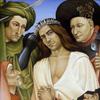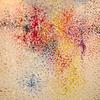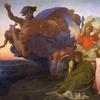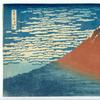Spirit and Essence, Line and Form: The Graphic Work of Henry Moore
- SAN MARINO, California
- /
- May 29, 2018
An exhibition focused on the surprising diversity of styles and subject matter found in the graphic art made by Henry Moore (1898-1986), the most prominent British sculptor of the 20th-century, will go on view at The Huntington Library, Art Collections, and Botanical Gardens on June 16. “Spirit and Essence, Line and Form: The Graphic Work of Henry Moore” celebrates the Philip and Muriel Berman Foundation’s gift to The Huntington of 337 of Moore’s works on paper with a display of 28 prints selected to highlight the range of intricate, often delicate works that explore the same universal themes found in Moore’s sculpture: the roots of creation, the body, life, and death. The exhibition runs through Oct. 1, 2018.
“One of the most exciting things about the Berman Collection is the great variety of work it represents,” said Melinda McCurdy, associate curator of British art and curator of the exhibition. “This exhibition gives visitors a chance to see how Moore’s exploration of the interrelationship of shape and mass we know from his sculptural work is put to work on paper—with subjects ranging from massive rocks at Stonehenge to the angles and depths of an elephant skull, then on to the complexity of a mother-child relationship. The Berman gift really allows us to represent one of the most influential British modernists in the broadest possible way.”
Famous for his monumental biomorphic sculptures, which are enjoyed by millions in museums and public spaces worldwide, Moore is less well known for his work as a graphic artist who produced drawings as well as prints—more than 700 over his career. Moore used prints to explore universal themes, but also to express topics that were deeply personal, reacting to the political and social climate of his time and to his own preoccupations.
The exhibition is organized along thematic lines.
Stonehenge
Moore experienced Stonehenge for the first time in 1921, at age 23. He took the train from London and arrived at a nearby hotel late in the evening. Impatient to see the prehistoric monument, he visited the site alone by moonlight and never forgot the impression it made on him. Decades later, when discussing his 1973 series of 18 lithographs, he recalled the moment. “Moonlight, as you know, enlarges everything,” he said, “and the mysterious depths and distances made [Stonehenge] seem enormous.”
“Many of Moore’s Stonehenge lithographs reinforce this sense of enormity,” said McCurdy. “A number of his prints offer close-up, partial views of the monoliths, as if it were impossible for him to capture them completely. This enhances their sublimity, creating a sense of vastness that provokes feelings of vulnerability, or of agelessness that reminds us of our own impermanence.”
Elephant Skull
Juxtaposing the study of Stonehenge’s enormity with one that focuses on the minute details of an individual object, the next section in the installation explores Moore’s interest in a single elephant skull. Naturalist Sir Julian Huxley gave Moore the object in the late 1960s. It became the subject of the artist’s near obsession with its angles, depths, and forms. Moore’s studies of the object developed into the Elephant Skull album, a portfolio of 45 etchings produced between 1969 and 1970. The prints explore the skull from a distance and extremely close up. Moore’s captions for the etchings indicate that he regarded the skull as an adaptable metaphor, one that recalled his own sculptural work, architectural elements, or features of the landscape.
Also part of this section of the exhibition is a later lithograph that reveals Moore’s continuing fascination with the elephant. “Unlike in his more abstract work, in this image it seems as though he revels in the living animal’s distinctive appearance, rendering the texture of its wrinkled skin in almost photographic detail,” said McCurdy.
While these two sections concentrate on particular portfolios of work, two other sections present individual prints with a broad range of themes.
Balancing Classical and Romantic sensibilities
Moore wrote, “When it’s all classic, it’s too obvious and cold and deadly perfect; when it’s all romantic, it’s too loose, uncontrolled, wildly chaotic, and shapeless.” He described his art as a balance of the Classical—rational, symmetrical, static, and geometric—and the Romantic—emotional, asymmetric, dynamic, and organic—and he responded to works of art that he believed exhibited these characteristics. Mesoamerican sculpture, for example, had what he felt was a “largeness of scale and a grim, sublime, austerity,” qualities that appear in his lithograph Mexican Mask (1974). He also admired the work of 18th-century Italian artist Giovanni Battista Piranesi, whose series of engraved Imaginary Prisons, showing strange labyrinthine subterranean vaults, inspired the setting for Reclining Figure Piranesi Background II (1979). Even when depicting architectural elements, Moore imbues the geometric structures with a sense of mystery by skewing their angles or enhancing their shadows.
An Artist’s Obsessions
While a number of works in the exhibition may seem uncharacteristic of Moore’s well-known style, several objects on view are more readily recognizable. For example, the softly rounded bodies in Five Reclining Figures (1979) are reminiscent of his large-scale bronze pieces, but in graphic form, utilizing two dimensions to explore the relationship between mass and volume at play in the artist’s sculptural work. “And they make you wonder, are these primordial icons, suggesting fertility, creation, or life itself?” said McCurdy. “Or do they represent the anxieties of the modern world, evoking such themes as sexuality, repression, and isolation?”
Another of Moore’s most repeated subjects, the mother and child, reveals the complexity of that relationship. One lithograph of a mother and child in “Spirit and Essence” recalls the sober image of a Renaissance Madonna and Child, while another shows a sculpture-like figure reaching tenderly for her baby.
“Moore was quite aware of his tendency for ‘obsession,’ and that attribute is part of what makes his graphic work so fascinating,” said McCurdy. “In print after print we are able to see the deep exploration of single subjects that occupied Moore over the course of his career and across media.”
Support for this exhibition is provided by Heather and Paul Haaga and the Susan and Stephen Chandler Exhibition Endowment.














100x100_c.jpg)